High-throughput, highly reproducible RNA analysis on the BioPhase 8800 system using the Empower Chromatography Data System (CDS)
The BioPhase 8800 driver for Empower software and the RNA 9000 Purity & Integrity kit
Jane Luo, Philip Hoang, Tingting Li and Sahana Mollah
SCIEX, USA
Abstract
In this technical note, the BioPhase 8800 driver for Empower software was used to operate and acquire data from the BioPhase 8800 system for RNA analysis. Data processing was performed using the Empower CDS. Combining the driver, the multi-capillary BioPhase 8800 system, the Empower CDS and the ready-to-use RNA 9000 Purity & Integrity kit enables highthroughput and highly reproducible analysis of RNA therapeutics in a fully compliant framework
Introduction
In recent years, the combination of new delivery technologies and an increased understanding of the role of RNA in various diseases has led to a surge of interest and investment in RNA therapeutics.1 As biopharmaceutical companies race to put their RNA therapeutics on the market, they face multiple challenges. They need high-throughput analytical tools to characterize the purity and integrity of RNA therapeutics quickly and reproducibly. They must also maintain GxP compliance with regulators such as the US Food and Drug Administration (21 CFR Part 11) and the European Medicines Agency (Annex 11)2,3 by demonstrating confidence in their data quality and integrity. The BioPhase 8800 driver for Empower software helps address these challenges.
With the driver, the BioPhase 8800 system becomes compatible with the Empower CDS. The driver allows full instrument control, method and sample set creation and management, enabling data collection directly from the Empower CDS. High-throughput and highly reproducible RNA analyses were achieved in a compliant environment using this driver with the BioPhase 8800 system, the RNA 9000 Purity & Integrity kit, and the Empower CDS.
Key features of the BioPhase 8800 driver for Empower software in RNA analysis
- The high-throughput, high-resolution capabilities of the BioPhase 8800 system are combined with the data integrity and compliance tools offered by the Empower CDS
- Highly reproducible data analysis of RNA therapeutics can be performed in a widely accepted compliance-ready framework
- The same RNA analysis workflow (Figure 1) can be used from discovery to product release, helping to ensure consistent and reliable results throughout the drug development process
Figure 1. A high-throughput, high-resolution RNA analysis workflow on the BioPhase 8800 system using the Empower CDS. The BioPhase 8800 driver for Empower software (driver location indicated by the blue star) was used to operate and acquire data from the BioPhase 8800 system utilizing a laser-induced fluorescence (LIF) detector while interfacing with the Empower CDS. RNA samples were separated by capillary electrophoresis (CE) on the BioPhase 8800 system using the RNA 9000 Purity & Integrity kit. Results from 6 single-stranded RNA (ssRNA) ladder injections were analyzed using the Empower CDS. The sizes of the fragments in the ssRNA ladder were indicated in bases.
Methods
Materials: The RNA 9000 Purity & Integrity kit (P/N C48231) was from SCIEX (Framingham, MA) and contained Nucleic Acid Extended Range Gel, SYBRTM Green II RNA Gel Stain*, Acid Wash/Regenerating Solution, CE Grade Water, and ssRNA Ladder (50 to 9,000 bases). BioPhase BFS capillary cartridge - 8 x 30 cm (P/N 5080121), BioPhase sample and reagent plates (P/N 5080311), and Sample Loading Solution (SLS) (P/N 608082) were from SCIEX. The 0.2 µm syringe filter (P/N 4612) was from PALL (Port Washington, NY). Rainin LTS filter tips were from Mettler Toledo (Oakland, CA).
The custom Alt-R CRISPR-Cas9 single guide RNA (sgRNA) targeting human HPRT (100 nt) was from Integrated DNA Technologies (Coralville, IA). This product contained chemical modifications to increase the sgRNA stability, potency and resistance against nuclease activity.4 The CleanCap Cas9 mRNA (20 μg, P/N L-7206-20) was from TriLink BioTechnologies (San Diego, CA). 5 The Cas9 mRNA was fully substituted with a 5-methoxyuridine modification. It had an expected size of 4,521 bases by agarose gel analysis and was shipped at a concentration of 1 mg/mL. The Cas9 mRNA was capped and polyadenylated, mimicking a fully processed, mature mRNA.
Instrument: A BioPhase 8800 system (P/N 5083590) equipped with a LIF detector was from SCIEX. The excitation wavelength was 488 nm, and the emission wavelength was 520 nm.
Software: The BioPhase 8800 driver for Empower software (P/N 5306620) from SCIEX was used to operate and acquire data from the BioPhase 8800 system utilizing the LIF detector while interfacing with the Empower CDS. The driver enables direct control of the BioPhase 8800 system hardware, sample setup, method design, data collection, and storage of multichannel data in the database of the Empower CDS alongside linked sample information, including sample identifier, sample set, method set, and instrument method. Post-acquisition, users have access to data processing, analysis and data management tools native to the Empower CDS, including 21 CFR Part 11 components such as electronic signatures on reports and signature record linking.
Cas9 mRNA sample preparation: The Cas9 mRNA sample (1 mg/mL stock solution from TriLink BioTechnologies) was aliquoted at 5 μL after thawing and stored at -80°C before use. A 0.4 ng/μL Cas9 mRNA solution was prepared for analysis with the BioPhase 8800 system. First, the Cas9 mRNA stock solution (1 mg/mL) was diluted with CE Grade Water to 100 ng/μL. Then, the Cas9 mRNA 100 ng/μL working solution was diluted tenfold using CE Grade Water to 10 ng/μL. Finally, the Cas9 mRNA at 10 ng/μL was diluted to 0.4 ng/μL by mixing 4 μL of the 10 ng/μL solution with 96 μL of a 50:50 (v/v) CE Grade Water/SLS solution to yield a total volume of 100 μL.
sgRNA sample preparation: The lyophilized sgRNA was resuspended in 10 mM Tris, pH 7.5, and 0.1 mM EDTA to a concentration of 100 μM or 3.25 μg/μL as the stock solution, and stored at -80°C in 10 μL aliquots before use. A 0.31 ng/μL sgRNA solution was prepared for analysis with the BioPhase 8800 system. First, the stock solution was diluted with CE Grade Water to 100 ng/μL. Next, 100 ng/μL working solution was diluted to 6.25 ng/μL with CE Grade Water. Finally, the 6.25 ng/μL sgRNA solution was diluted to 0.31 ng/μL by mixing 5 μL of the 6.25 ng/μL solution with 95 μL of a 50:50 (v/v) CE Grade Water/SLS solution to yield a total volume of 100 μL.
Cas9 mRNA and sgRNA co-analysis: For the co-analysis of the Cas9 mRNA and the sgRNA, 4 μL of the 10 ng/μL Cas9 mRNA solution and 5 μL of the 6.25 ng/μL sgRNA solution were mixed with 91 μL of a 50:50 (v/v) CE Grade Water/SLS solution to yield a total volume of 100 μL.
ssRNA ladder preparation: The ssRNA ladder was prepared according to the application guide for the RNA 9000 Purity & Integrity kit.6 For each sample well, 4 μL of the ssRNA ladder was mixed with 96 μL of the SLS solution to yield a total volume of 100 μL. The number of prepared ssRNA ladder samples depended on the replicates needed.
RNA sample handling and preheat treatment: RNA samples are prone to degradation. Therefore, filter tips were used for all steps of sample handling. Before analysis on the BioPhase 8800 system, 100 μL of each RNA sample was heated using a thermal cycler at 70°C for 5 minutes and then immediately placed in an ice water bath for at least 2 minutes. After that, the samples were transferred to the sample plate at 98 μL per well. Finally, sample plates were centrifuged at 400 rpm (20 x g) for 4 minutes in an Allegra X-30 Series Benchtop Centrifuge (Beckman Coulter) with an S6096 microplate rotor before loading onto the BioPhase 8800 system.
Data acquisition with the BioPhase 8800 driver for Empower software: First, 3 methods validated for the BioPhase 8800 system, 6 Conditioning Method - RNA 9000, Separation Method - Electrokinetic Injection - RNA 9000, and Shutdown Method - RNA 9000, were imported into Empower CDS to create instrument methods and method sets for use with the Empower CDS connected by the driver to a selected BioPhase 8800 system. Next, the sample set method with sample information was created using the Sample Set Method Editor accessible within the Run Samples window in the Empower CDS. After the sample set method was saved to the database of the Empower CDS, the selected BioPhase 8800 system was prepared using the commands within the status panel in the driver, including loading the cartridge and setting the sample storage temperature as 10°C, the cartridge temperature as 20°C and the LIF laser as “ON.” The sample and reagent plate layouts were then printed using the driver to aid their preparation. After the specified temperatures for sample storage and cartridge were reached, sample and buffer plates were loaded on the BioPhase 8800 system. The sample run was started by selecting the “Run Samples,” “Load using a previously created sample set method” and “Run” commands.
Data processing: The Empower CDS was used to analyze the data acquired. To calculate the time-corrected peak area, “CE” must be selected as the new processing method. A data processing method for each sample category was created by specifying different peak integration parameters, such as width, positive threshold, minimum cluster distance, and inhibit integration, and automatically applied to raw data in the same sample category. The results table containing the migration time, time-corrected peak area and time-corrected peak area percentage was exported through the Empower CDS as a report and as a .csv file.
Operational control and data acquisition using the BioPhase 8800 driver for Empower software
The status panel in the BioPhase 8800 driver for Empower software (Figure 2) enables users to load and eject cartridges in the BioPhase 8800 system, prime, equilibrate and condition the instrument through individual action controls such as voltage, light source, rinse, sample injection, separate, sample temperature and separation temperature. These operational control processes were monitored and reported in real time, as seen in Figure 2B. While the instrument performed each specific task, the control buttons were greyed out to prevent any interference with the instrument’s operation. During data acquisition, all 8 capillaries were simultaneously monitored in real time via detector response, current, voltage and pressure in the Trace View. As shown in Figure 2C, the electropherogram for capillary D shows that 3 size standard fragments (50, 150 and 300 bases) of the ssRNA ladder were detected in 11.5 minutes. To simplify sample and reagent plate preparation, the BioPhase 8800 driver for Empower software provides specific user interfaces to create and edit instrument methods and sequences with built-in, CE-specific validation and printouts for sample plate and reagent plate layouts.
Figure 2. The status panel in the BioPhase 8800 driver for Empower software. Panel A shows the table of the active sample sets with sample names, well positions and instrument methods indicated. Panel B provides commands for instrument control and real time monitoring of instrument status. Panel C displays the Trace View for real time monitoring of detector response, current, voltage and pressure for all 8 capillaries. In this example, the electropherogram for capillary D shows that 3 size standard fragments (50, 150 and 300 bases) of the ssRNA ladder were detected in 11.5 minutes.
High-throughput RNA analysis using the BioPhase 8800 driver for Empower software
Figure 3 shows 6 samples—the sgRNA, 2 different lots of the Cas9 mRNA, a mixture of the sgRNA and Cas9 mRNA, the ssRNA ladder and a blank—that were separated by CE-LIF on the BioPhase 8800 system through the control of the driver during the same run. The size of the sgRNA is 100 bases. It migrated between the 50-base and 150-base size standard fragments. The Cas9 mRNA with a length of 4,521 bases was detected between the 3,000-base and 5,000-base size standard fragments. In the sgRNA and the Cas9 mRNA co-analysis sample (green trace), the migration times of the sgRNA and the Cas9 mRNA were consistent with when they were injected alone. This analysis helps verify their coexistence when both are being delivered as RNA therapeutics by the same vehicle, such as a lipid nanoparticle (LNP). In a quality control (QC) environment, lot-to-lot variation studies are conducted to monitor product quality and any possible shift in manufacturing processes. The Cas9 mRNA from TriLink BioTechnologies is fully substituted with a 5-methoxy-U modification with a naturally occurring Cap 1 structure and a polyA tail, mimicking a fully processed, mature mRNA. It has high capping efficiency and is optimized for mammalian systems. Therefore, the Cas9 mRNA was used here as an example of an mRNA therapeutic. Two different Cas9 mRNA lots were analyzed and impurities were detected, as indicated by the bracket. Lot 1 (red trace) had a purity of 45.73% while lot 2 (pink trace) was 58.08% pure. Although lot 2 contains fewer impurities, 2 distinct impurity peaks with sizes of about 3,000 bases and 1,500 bases were detected. The impurities in lot 1 consist of many fragments with gradually decreasing sizes. These results demonstrate that the BioPhase 8800 system suits lot-to-lot variation studies in a QC environment. Clearly, the high-throughput RNA analysis capability of the BioPhase 8800 system, coupled with the compliance environment provided by the Empower CDS, enables the processing of a large amount of RNA therapeutics of an extended size range for either development or QC release.
Figure 3. Simultaneous analysis of multiple RNA samples during a single run. The sgRNA, 2 different lots of the Cas9 mRNA, a mixture of the sgRNA and Cas9 mRNA, the ssRNA ladder and a blank were separated on the BioPhase 8800 system through the control of the BioPhase 8800 driver for the Empower software. The blank was a 50:50 (v/v) CE Grade Water/SLS solution. The sizes of the RNA fragments in the ssRNA ladder are indicated in bases.
Robust and reproducible purity analysis of the Cas9 mRNA
The Cas9 mRNA encodes the Cas9 enzyme, a critical part of the CRISPR (clustered regularly interspaced short palindromic repeats) gene-editing system. CRISPR/Cas9 gene editing can potentially treat many human diseases, and numerous ongoing clinical trials are focused on Cas9 mRNA and sgRNA that can target a faulty gene to cure a disease. Here, a Cas9 mRNA sample was injected 6 times from the same well to assess the injection repeatability. As shown in Figure 4, the migration time (MT) of the intact Cas9 mRNA and peak profile was consistent among the 6 injections with the percent relative standard deviation (%RSD) values of 0.37% and 1.03% for MT and corrected peak area percentage (CPA%), respectively. These results demonstrate the excellent robustness of Cas9 mRNA analysis using the BioPhase 8800 driver for Empower software. An example of a report for Cas9 mRNA analysis is shown in Figure 5. Information on the sample, data acquisition, and data processing method was provided in the top panel of the report. The electropherogram with peak assignment and annotation was shown in the middle panel of the report. The “Peak Results” table and the “Result Sign Off" table with the audit trail were included in the bottom panel of the report.
Figure 4. A robust and reproducible Cas9 mRNA purity analysis was conducted using the BioPhase 8800 driver for Empower software. The Cas9 mRNA was injected 6 times and analyzed by CE-LIF on the BioPhase 8800 system. The table inset summarizes the MT and CPA% for 6 injections.
Excellent assay repeatability of RNA analysis
The assay repeatability of RNA analysis was also assessed by injecting the ssRNA ladder 6 times from the same sample well. Figure 6 shows the overlay of ssRNA ladder results obtained with one representative capillary out of the 8 capillaries. MT for all size standard fragments and the peak profiles in all 6 injections were consistent with the baseline resolution of the 5,000-, 7,000- and 9,000-base fragments. Table 1 summarizes the average and %RSD values for the MT and CPA%. The %RSD was 0.30% or better for the MT for all 8 size standard fragments listed in Table 1. The %RSD for CPA% was below 2.00% for all 8 size standard fragments. In summary, excellent assay repeatability of RNA analysis using the BioPhase 8800 driver for Empower software was demonstrated.
Table 1. Assay repeatability among 6 injections: %RSD of MT and CPA% of RNA markers in the ssRNA ladder. N=6.
Figure 5. Cas9 mRNA report generated using the Empower CDS. The top panel lists sample, data acquisition and data processing method information. The middle panel displays the electropherogram with peak integration and annotation. Finally, the lower panel shows the “Peak Results” table and the “Result Sign Off” table with the audit trail.
Figure 6. Excellent assay repeatability. The ssRNA ladder was injected 6 times from the same sample well to assess assay repeatability. The sizes of the RNA fragments in the ssRNA ladder are indicated in bases with numbers in black font.
High intra- and inter-capillary reproducibility of RNA analysis
The intra-capillary reproducibility of the RNA analysis was evaluated by injection of the ssRNA ladder in the same capillary but in different well positions. Figure 7 illustrates the overlay of 6 electropherograms obtained by injecting the ssRNA ladder from 6 different columns with the same capillary. Each trace displays the high resolution of the size standard fragments. Table 2 summarizes the average and %RSD values for the MT and CPA%. The %RSD indicated excellent reproducibility for MT of better than 0.55%. The %RSD for CPA% was better than 3.50% for all size standard fragments listed in Table 2.
The inter-capillary reproducibility of the RNA analysis was assessed by injection of the ssRNA ladder across 8 capillaries. The overlay of the ssRNA ladder obtained from capillaries A through H in a single injection indicated consistent MT and peak profile across all capillaries (data not shown). Table 3 summarizes the average and %RSD values for the MT and CPA%. It is worth noting that excellent inter-capillary reproducibility was obtained with %RSD for MT better than 0.60%. In addition, the %RSD for CPA% was better than 3.00% for all size standard fragments listed in Table 3, indicating outstanding inter-capillary reproducibility.
Table 2. Intra-capillary reproducibility: %RSD of MT and CPA% of RNA markers in the ssRNA ladder. N=6.
Figure 7. Good intra-capillary reproducibility of MT and CPA% for the ssRNA ladder. The ssRNA ladder was injected from 6 different columns (well positions) in a single capillary to assess intra-capillary repeatability. The sizes of the RNA fragments in the ssRNA ladder are indicated in bases with numbers in black font.
Outstanding overall assay reproducibility
The overall assay reproducibility was evaluated by injecting the ssRNA ladder 6 times in each of the 8 different capillaries, collecting 48 electropherograms. Table 4 summarizes the average and %RSD values for the MT and CPA%. The %RSD demonstrated excellent reproducibility for MT of better than 1.30%. The %RSD for CPA% was better than 4.80% for all size standard fragments listed in Table 4. Furthermore, the average CPA% value for each size standard fragment obtained with 48 injections (Table 4) was within 3.00% of the corresponding value obtained in the assay repeatability study (Table 1), intra-capillary reproducibility study (Table 2) and inter-capillary reproducibility study (Table 3), demonstrating excellent overall assay reproducibility.
Table 3. Inter-capillary reproducibility: %RSD of MT and CPA% of RNA markers in the ssRNA ladder. N=8.
Table 4. Overall assay reproducibility (%RSD) of MT and CPA% of RNA markers in the ssRNA ladder. N=48.
Conclusion
- The BioPhase 8800 driver for Empower software demonstrates outstanding compatibility between the Empower CDS and the BioPhase 8800 system by allowing users to control the instrument, create and edit methods, collect data, and analyze data directly within the Empower CDS
- High-throughput RNA analysis using the driver was demonstrated over an extended size range
- Excellent assay repeatability was obtained with both the ssRNA ladder and the Cas9 mRNA sample
- Excellent intra-capillary, inter-capillary and overall assay reproducibility was achieved for RNA analysis
- Lot-to-lot variation analysis of the Cas9 mRNA revealed interesting differences in the impurity profile between 2 lots
- The benefit of BioPhase 8800 driver for Empower software was demonstrated to enable high-throughput, highly reproducible RNA analysis in a fully compliant-ready framework
References
- Damase, TR et al. The Limitless future of RNA therapeutics. Front. Bioeng. Biotechnol. 2021 March 18, 9: 1–24. Article 628137. PMID 33816449. https://doi.org/10.3389/fbioe.2021.628137.
- US Food and Drug Administration. Guidance for Industry, Part 11, Electronic Records; Electronic Signatures — Scope and Application. August 2003. https://www.fda.gov/media/75414/download.
- European Commission, Health and Consumers DirectorateGeneral. The Rules Governing Medicinal Products in the European Union, Volume 4, Good Manufacturing Practice, Medicinal Products for Human and Veterinary Use – Annex 11: Computerised Systems. Revision January 2011. https://health.ec.europa.eu/system/files/2016- 11/annex11_01-2011_en_0.pdf.
- Integrated DNA Technologies. Genome editing with CRISPR-Cas9. https://www.idtdna.com/pages/products/crispr-genomeediting/alt-r-crispr-cas9-system.
- TriLink BioTechnologies, part of Maravai LifeSciences. CleanCap CRISPR Associated Protein 9 mRNA (5- methoxyuridine). https://www.trilinkbiotech.com/cleancap-sup-r-sup-cas9- mrna-5mou.html#additional
- RNA 9000 Purity & Integrity kit for the BioPhase 8800 system, application guide, RUO-IDV-05-13438-B.
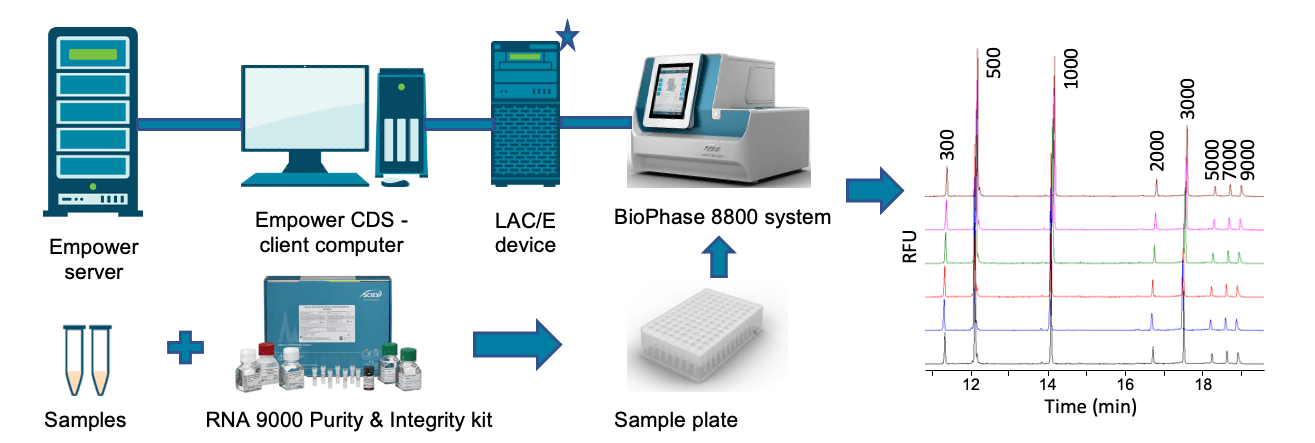 Click to enlarge
Click to enlarge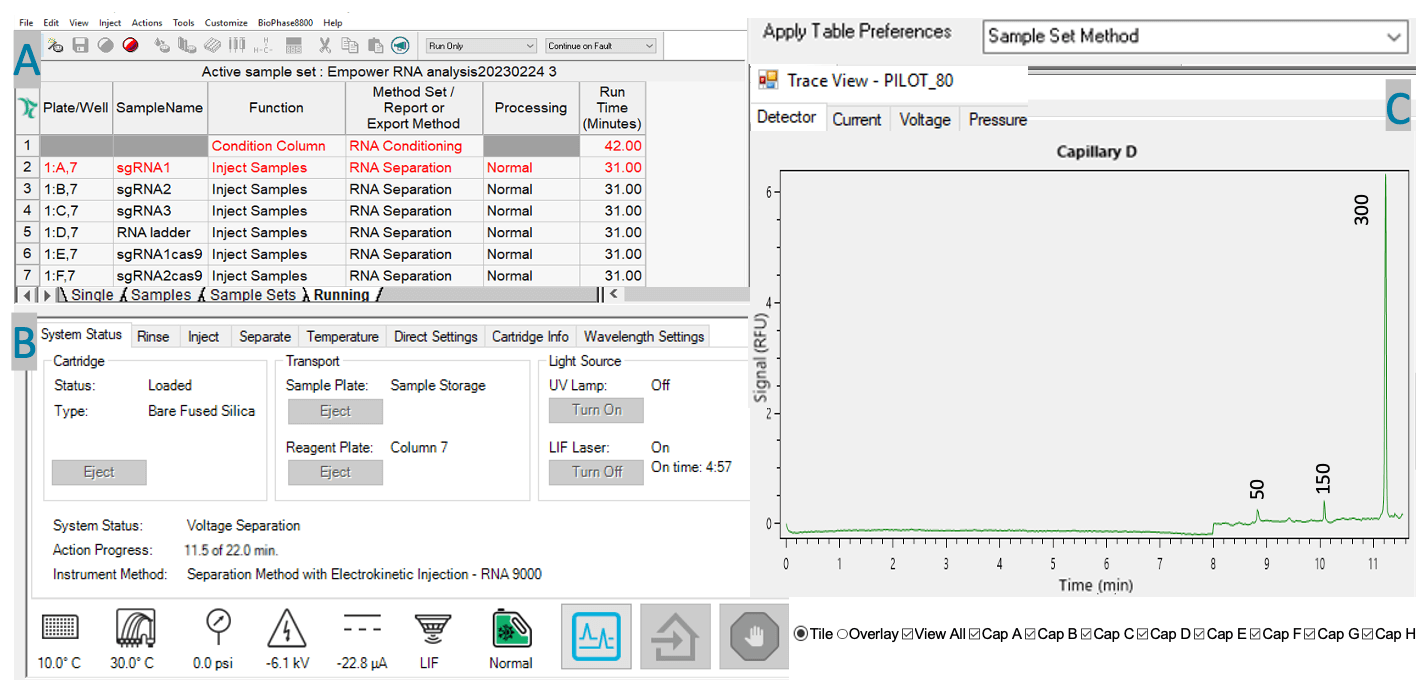 Click to enlarge
Click to enlarge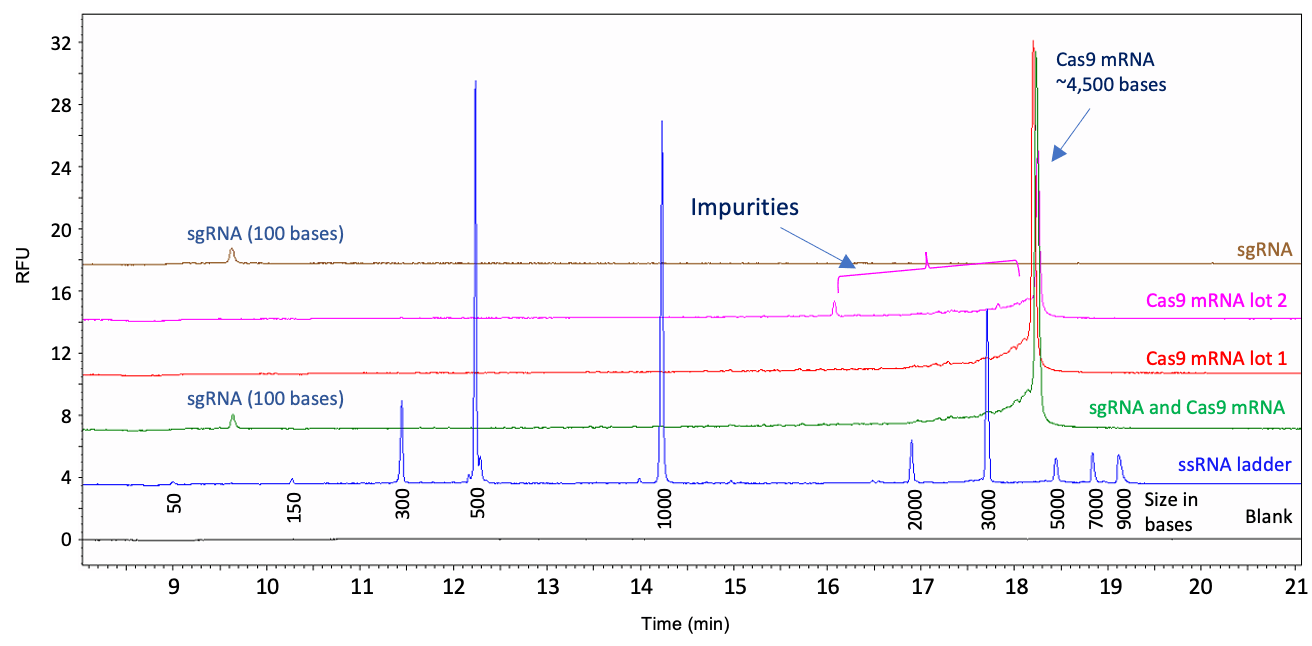 Click to enlarge
Click to enlarge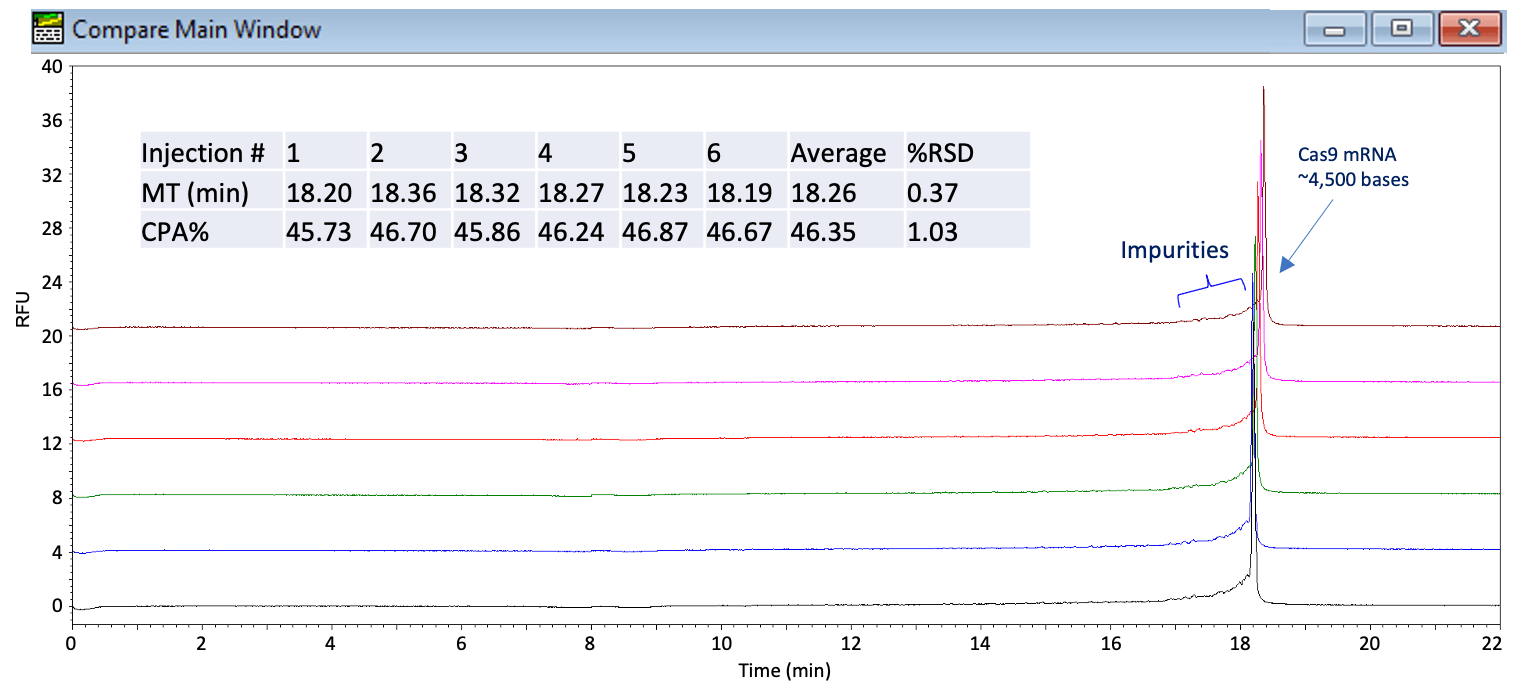 Click to enlarge
Click to enlarge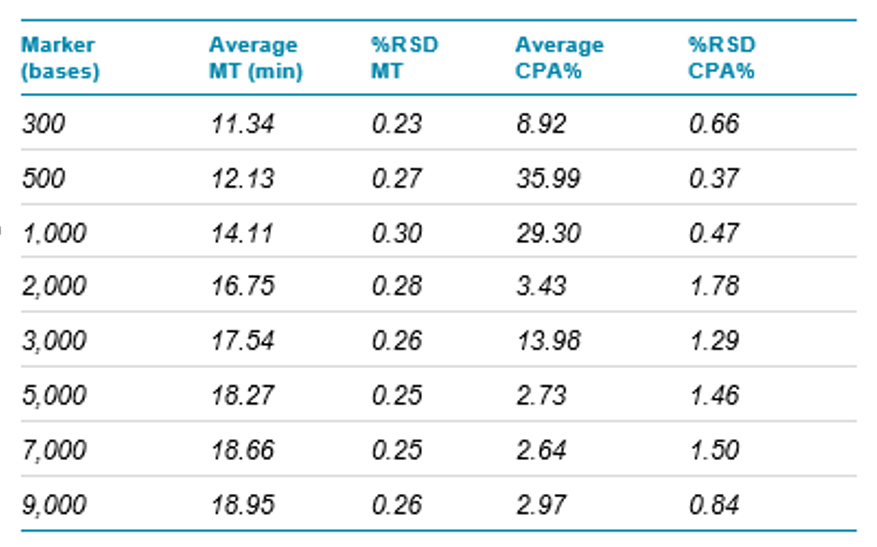 Click to enlarge
Click to enlarge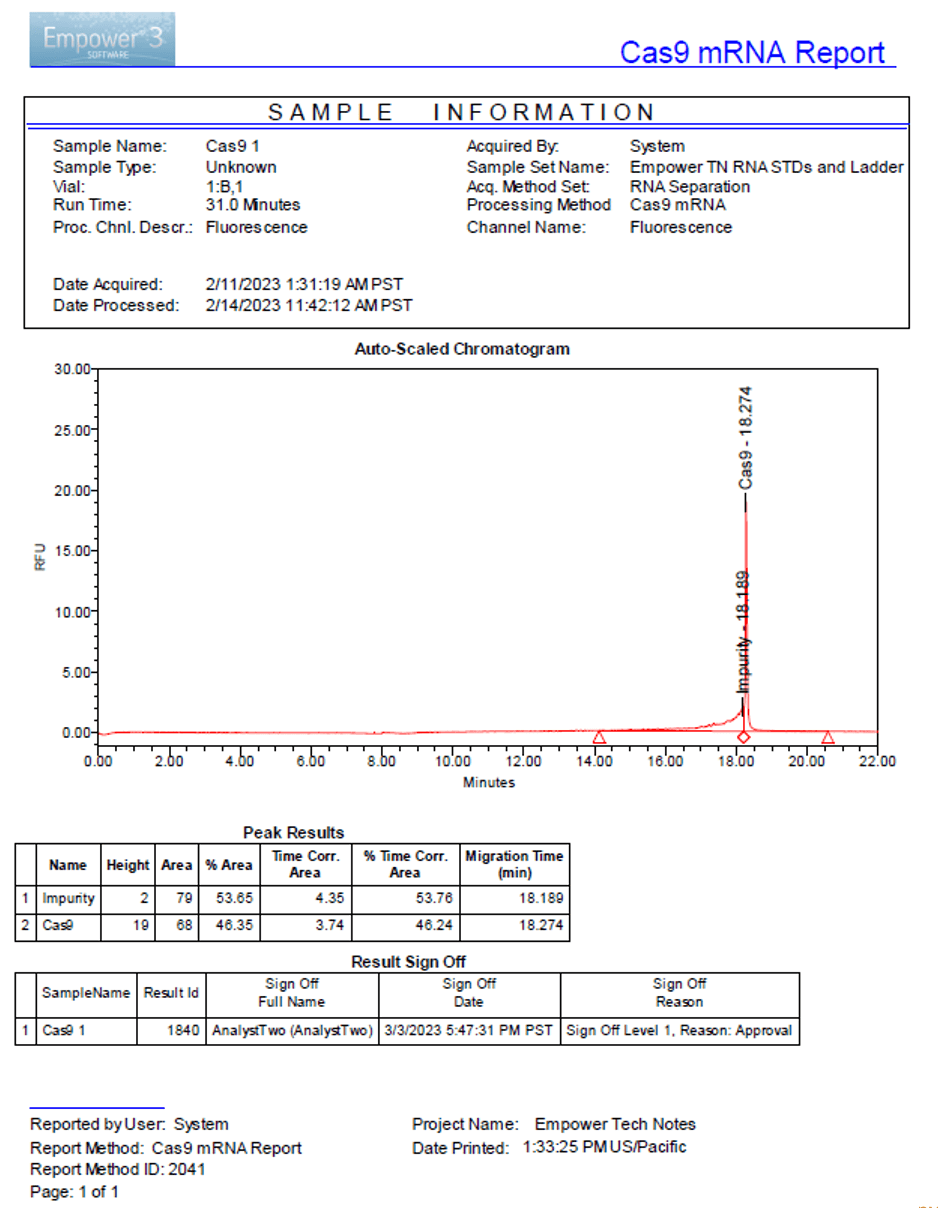 Click to enlarge
Click to enlarge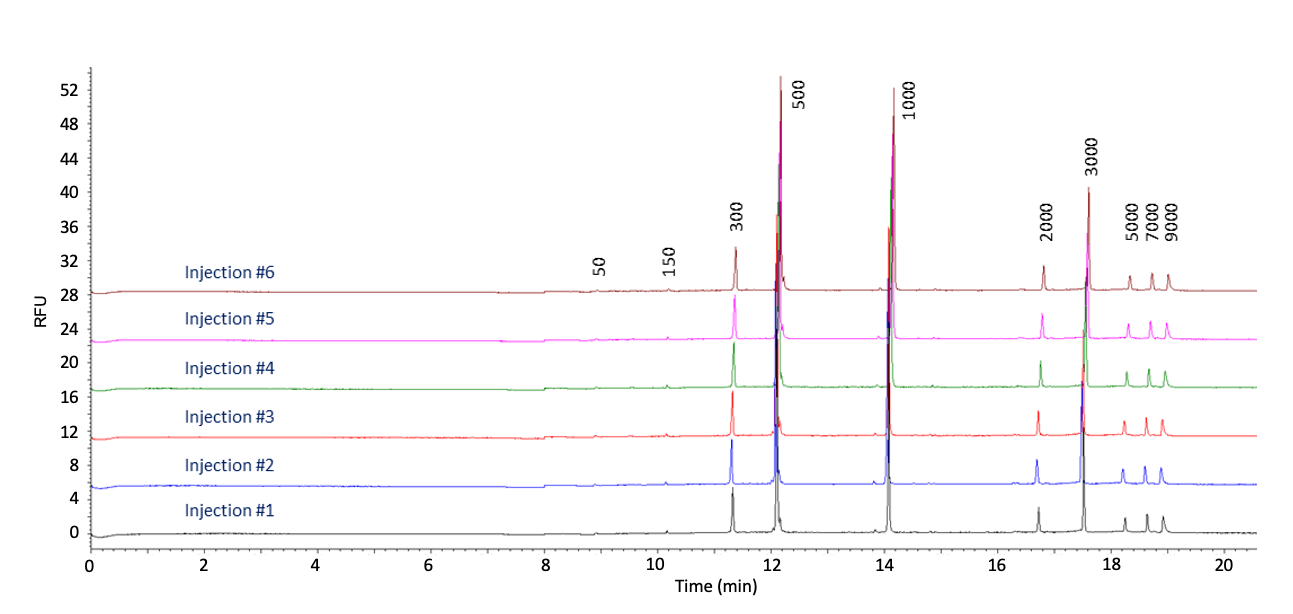 Click to enlarge
Click to enlarge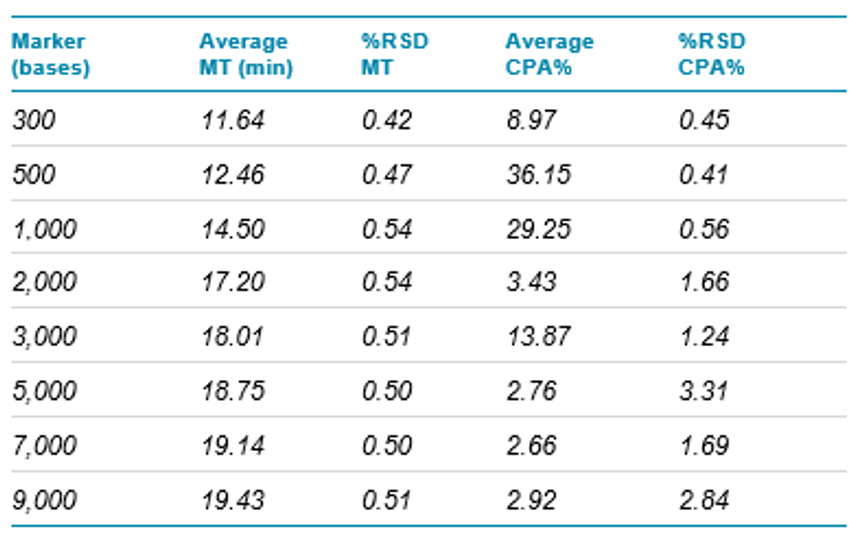 Click to enlarge
Click to enlarge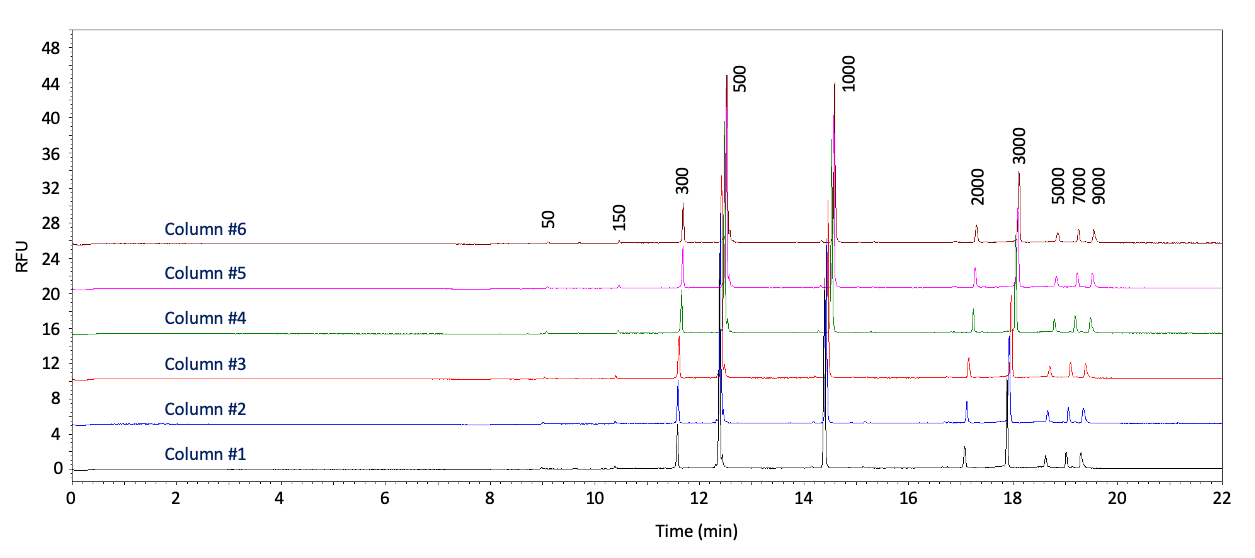 Click to enlarge
Click to enlarge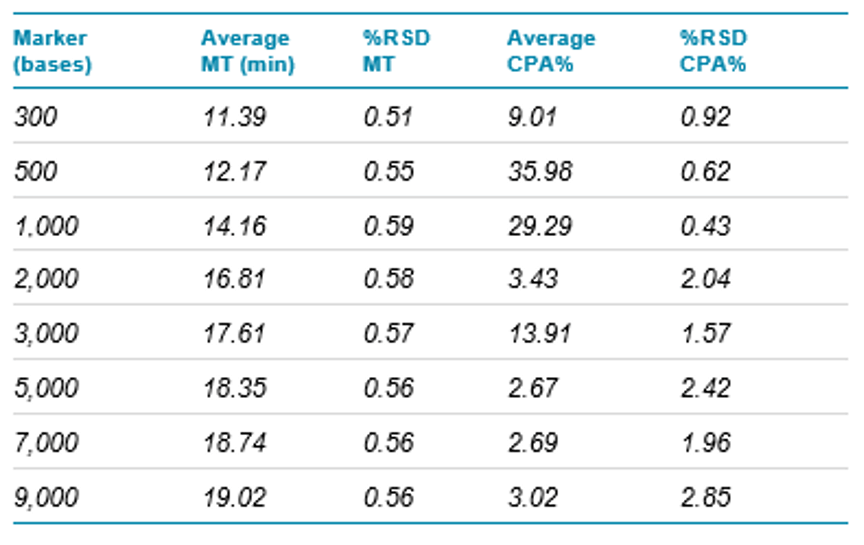 Click to enlarge
Click to enlarge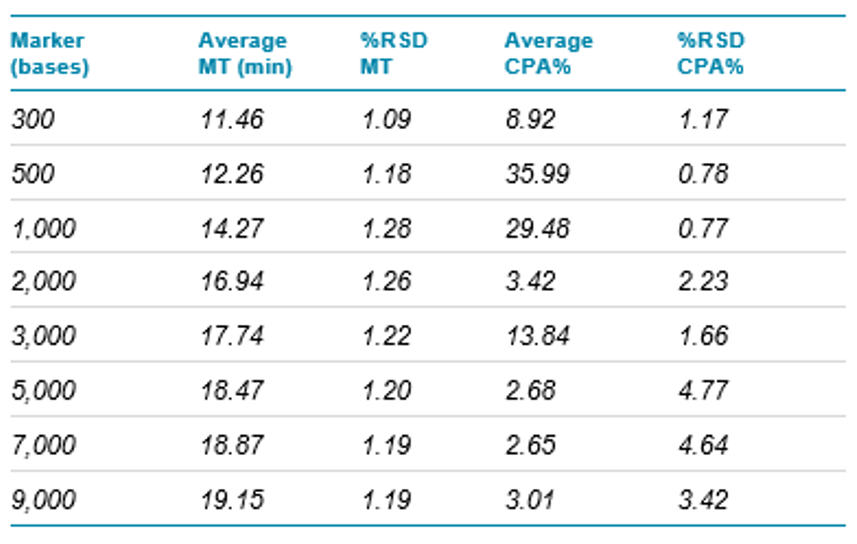 Click to enlarge
Click to enlarge